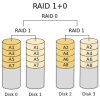- Joined
- Nov 26, 2016
- Messages
- 583
- Points
- 28
How well do RAID 1 and RAID 10 compare performance wise?
I am checking these shared hosting offers
They are mentioning to RAID 10 but there are a lot of companies use RAID-1, I can't decide which would be best for a web server. What is your opinion?
I am checking these shared hosting offers
Code:
https://forumweb.hosting/14347-7€-year-gt-cpanel-ssd-cloudlinux-litespeed-free-ssl-unmeterd-ddos-protection-gt-30-off.html
https://forumweb.hosting/14386-new-year-offer!-75-off-on-all-shared-hosting-plans-limited-period-offer-!!.html
https://forumweb.hosting/14468-30-lifetime-discount!-ssd-web-hosting-from-localnode-cpanel-softaculous-cloudlinux.html










